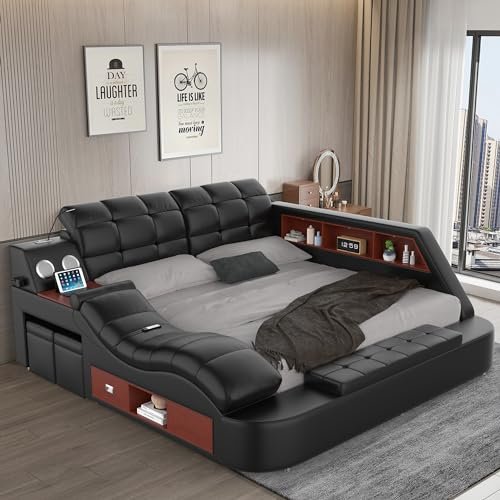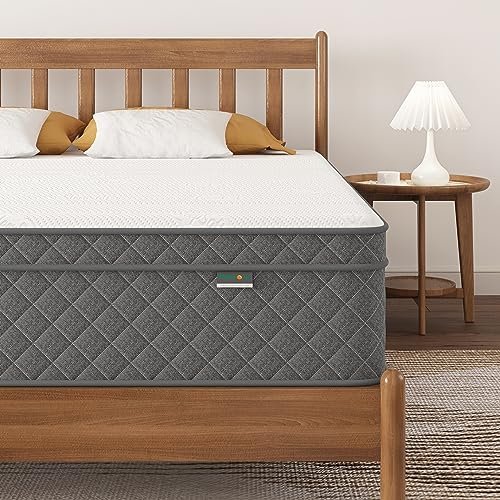Recommended Product:
Are you dreaming of a future where your bed doesn’t just hold you but actively enhances your sleep? Welcome to the world of smart beds! Far more than just a place to rest, these innovative sleep systems promise to revolutionize your nightly routine, offering personalized comfort and insights that can transform your well-being. But with so many options and technologies emerging, you might be asking: “What is the best smart bed for me?”
The answer, as you’ll soon discover, isn’t a one-size-fits-all product. The “best” smart bed is the one that perfectly aligns with your unique sleep needs, preferences, and lifestyle. This friendly guide will help you navigate the exciting landscape of smart sleep technology, empowering you to make an informed decision without ever feeling overwhelmed.
Why Even Consider a Smart Bed? The Benefits Beyond Basic Comfort
Before diving into features, let’s understand why so many people are turning to smart beds. They offer a host of advantages that traditional mattresses simply can’t match:
- Personalized Comfort: Say goodbye to “too firm” or “too soft.” Smart beds often allow for dynamic adjustability, letting you fine-tune your sleep surface with precision.
- Enhanced Sleep Tracking & Insights: Many smart beds come equipped with advanced sensors that monitor your sleep patterns, heart rate, breathing, and more. This data can provide actionable insights into your sleep quality, helping you identify areas for improvement.
- Targeted Health & Wellness Features: From snore detection and response to integrated temperature control, smart beds aim to address common sleep disturbances and promote overall health.
- Convenience & Smart Home Integration: Imagine your bed automatically adjusting as you drift off, or integrating with your smart home system to dim the lights and lock the doors. Smart beds offer a new level of seamless living.
- Future-Proofing Your Sleep: As technology evolves, many smart beds are designed to be updated, potentially offering new features and improvements over time.
What Makes a Bed “Smart”? Key Features to Look For
The “smart” in smart bed can encompass a wide range of technologies. Here are the core categories of features you’ll encounter:
1. Personalized Adjustability & Support
This is often the cornerstone of a smart bed. It’s about more than just raising the head or foot.
- Zoned Air Chambers: Many smart beds use internal air chambers that can be inflated or deflated to customize firmness levels for different parts of your body, such as your lumbar region or shoulders. This can be controlled via an app or remote.
- Automatic Adjustments: Some advanced systems can automatically adjust firmness throughout the night based on your movements, ensuring continuous optimal support.
- Position Presets: You can save your favorite settings for reading, watching TV, or sleeping, making it easy to return to your ideal position with a single touch.
2. Advanced Sleep Tracking & Insights
Beyond a wearable, a smart bed can track your sleep directly from beneath you.
- Biometric Sensors: These can monitor your heart rate, breathing rate, and movements throughout the night without requiring you to wear anything.
- Sleep Stage Analysis: Many systems can accurately detect when you’re in light sleep, deep sleep, or REM sleep, offering a detailed breakdown of your sleep cycles.
- Personalized Sleep Reports: Through a connected app, you’ll receive daily or weekly reports with insights into your sleep quality, potential disturbances, and personalized recommendations for improvement.
3. Integrated Temperature Control
Ever wake up too hot or too cold? Smart beds can help.
- Active Cooling & Heating: Some systems feature technology that can actively heat or cool the bed surface, maintaining your ideal temperature for optimal sleep.
- Dual-Zone Control: For couples, this is a game-changer! You and your partner can each set your preferred temperature zone on your side of the bed.
4. Snore Detection & Response
A common nuisance, now with a smart solution.
- Snore Sensing: Microphones or vibration sensors can detect when you start to snore.
- Gentle Adjustments: Upon detecting snoring, some beds can gently raise your head a few degrees to open your airway, potentially reducing or stopping the snoring without fully waking you.
5. Smart Home & App Integration
Connect your bed to your digital world.
- Voice Control: Command your bed using voice assistants like Alexa or Google Assistant.
- Automated Routines: Integrate with other smart home devices. Imagine your bed raising you gently in the morning as your lights slowly brighten and your coffee maker starts brewing.
- Intuitive Apps: Most smart beds are controlled via a user-friendly app, offering a dashboard for all your settings and sleep data.
6. Comfort Enhancements
Beyond the “smart” features, these beds are still about comfort.
- Massage Functions: Some offer various massage modes to help you relax before sleep or soothe sore muscles.
- Under-Bed Lighting: Gentle, motion-activated lighting can help you navigate in the dark without disturbing your partner.
Your Step-by-Step Guide to Finding YOUR Perfect Smart Bed
Recommended Product:
Ready to find your match? Follow these steps to narrow down your options and identify the features that matter most to you.
Step 1: Understand Your Sleep Needs & Goals
This is the most crucial first step. Before looking at any technology, reflect on your current sleep situation:
- What are your biggest sleep challenges? (e.g., waking up hot, snoring, back pain, difficulty falling asleep, inconsistent sleep).
- What do you hope to gain from a smart bed? (e.g., better sleep insights, relief from aches, improved sleep quality, convenience, relationship harmony).
- Do you have any specific health conditions that could benefit from adjustable support or tracking (e.g., acid reflux, sleep apnea, chronic pain)?
Tip: Keep a simple sleep journal for a week or two. Note down when you go to bed, wake up, any disturbances, and how you feel upon waking. This can reveal patterns you didn’t notice before.
Step 2: Prioritize Features Based on Your Needs
Now, revisit the “Key Features to Look For” section. Given your sleep needs from Step 1, which features are “must-haves,” which are “nice-to-haves,” and which are “not important”?
- Example 1 (Couple with Snoring & Temperature Issues):
- Must-Haves: Snore detection/response, dual-zone temperature control, dual-zone firmness adjustability.
- Nice-to-Haves: Advanced sleep tracking, massage.
- Not Important: Under-bed lighting.
- Example 2 (Individual with Back Pain & Curiosity about Sleep Health):
- Must-Haves: Zoned firmness adjustability, advanced sleep tracking with insights.
- Nice-to-Haves: Automatic adjustments, smart home integration.
- Not Important: Snore response, dual-zone features.
Bold Tip: Focus on solving your biggest sleep problems first. Don’t get distracted by flashy features you don’t actually need.
Step 3: Consider Your Budget
Smart beds represent a significant investment. Determine a realistic budget range before you start exploring. Remember that price often reflects the number and sophistication of features.
- Entry-level smart beds might offer basic adjustability and simple sleep tracking.
- Mid-range options introduce more advanced adjustability, better tracking, and perhaps some temperature control.
- High-end systems typically combine all the premium features, advanced sensors, and seamless integration.
Bold Tip: Think of a smart bed as an investment in your health and well-being. While cost is a factor, don’t compromise on features essential to solving your core sleep problems if your budget allows for a better solution.
Step 4: Think About Size, Space, and Compatibility
- Size: Do you need a Queen, King, or California King? Ensure it fits your bedroom comfortably.
- Foundation: Many smart beds are integrated systems, but some might be compatible with existing bed frames. Clarify if you need a specific type of base or frame for the smart bed’s functionalities to work.
- Installation: Some smart beds can be complex to set up. Consider if you’re comfortable with DIY assembly or if professional installation is offered/required.
Step 5: Research & Compare (Features, Not Products)
Now that you know what you need, you can research how different technologies address those needs.
- Dive into technology descriptions: Look at how various smart bed systems handle adjustability, sleep tracking accuracy, and temperature regulation. Do they use air chambers, gel layers, or something else?
- Read user experiences (generically): Search for discussions about the types of features you prioritized. For example, “experiences with snore detection beds” or “reviews of dual-zone temperature control.”
- Understand the data: How is sleep data collected? Is it stored securely? Can it be integrated with other health apps you use?
Bold Tip: Do not get bogged down by brand names at this stage. Focus purely on the functionality and efficacy of the features themselves, comparing how different approaches to smart sleep address your prioritized needs. Look for clear explanations of how the technology works, not just marketing claims.
Step 6: Explore Trial Periods, Warranties, and Customer Support
Because a smart bed is a long-term commitment, it’s vital to protect your investment.
- Generous Trial Periods: Sleep is highly personal. Look for brands that offer at least a 30-day (preferably longer) in-home trial period. This allows you to truly experience the bed over time and ensure it meets your expectations.
- Comprehensive Warranties: Understand what’s covered (electronics, mattress components, frame) and for how long. A strong warranty indicates confidence in the product’s durability.
- Accessible Customer Support: If something goes wrong or you have questions, you’ll want reliable support. Check reviews on the quality and responsiveness of customer service for various technologies.
Tips for a Smooth Smart Bed Journey
- Read the Fine Print: Always understand the return policy, warranty details, and any subscription fees associated with app features or advanced analytics.
- Think Long-Term: A smart bed is a significant purchase. Consider the longevity of the technology and the company behind it. Will it be supported with software updates for years to come?
- Don’t Overlook Simplicity: Sometimes, the best solution isn’t the one with the most features, but the one that most effectively addresses your core needs without unnecessary complexity.
- Consider Installation: Some smart beds require more involved setup. Factor in the effort or cost of professional installation if it’s not a DIY-friendly option for you.
- Data Privacy Matters: Since smart beds collect personal biometric data, understand how your data is collected, stored, and used. Look for companies with strong privacy policies.
Common Mistakes to Avoid
- Focusing Only on Price: While budget is important, choosing the cheapest option might mean missing out on crucial features that would genuinely improve your sleep. Value is about features that solve your problems, not just the lowest cost.
- Ignoring Your Partner’s Needs: If you share a bed, ensure the smart bed offers dual-zone capabilities for adjustability and temperature control to keep both of you happy.
- Underestimating Installation Complexity: Don’t assume all smart beds are plug-and-play. Some require significant assembly or specific electrical outlets. Read installation guides carefully.
- Not Understanding Data Usage: Simply buying a smart bed without understanding its data collection can lead to privacy concerns later. Always review data policies.
- Skipping the Trial Period: This is perhaps the biggest mistake. Never commit to a smart bed without taking advantage of a trial period to ensure it’s truly the right fit for your unique sleep.
Conclusion: Your Best Sleep Awaits!
Finding “the best smart bed” is a personal quest, not a search for a single product. By understanding your own sleep needs, prioritizing features, and following a thoughtful research process, you’ll be well-equipped to discover the smart sleep solution that’s perfect for you.
Remember, a good night’s sleep is invaluable. Investing in a smart bed that truly supports your well-being can lead to improved health, mood, and overall quality of life. Start exploring with confidence, knowing you’re on the path to finding your perfect sleep sanctuary!
Recommended Product:
FAQ
Q. What exactly defines a “smart bed” and how does it differ from a standard adjustable bed?
A. A smart bed goes significantly beyond a standard adjustable bed by integrating advanced technology like sensors, artificial intelligence, and connectivity. While an adjustable bed primarily allows you to manually or remotely change the bed’s position, a smart bed can automatically react to your body’s needs, track sleep patterns, offer personalized insights, regulate temperature, and often integrate with other smart home devices. It creates a more interactive, data-driven, and often automated sleep experience aimed at optimizing rest.
Q. What are the key features I should prioritize when looking for the best smart bed for me?
A. Prioritize features based on your specific sleep challenges and preferences. Essential considerations include advanced adjustability for comfort and support, integrated sleep tracking for personalized insights, snore detection with automatic head elevation, precise temperature control for an optimal sleep climate, and potentially massage functions for relaxation. Also, assess smart home integration capabilities if you want it to connect with other devices, and the user-friendliness of its control app.
Q. How can I determine which smart bed is truly “best” for my individual sleep needs and problems?
A. The “best” smart bed is highly personal. Begin by identifying your primary sleep issues—be it back pain, snoring, overheating, difficulty falling asleep, or restless nights. Research beds that offer specific technological solutions to these problems. Consider your budget, desired level of technological interaction, and the ease of use. Reading independent reviews and, if possible, trying different models in person can also significantly help in making an informed decision tailored to your unique requirements.
Q. Are smart beds a worthwhile investment, considering their higher price point compared to traditional beds?
A. For many individuals, smart beds represent a worthwhile investment due to their potential to significantly improve sleep quality and overall well-being. The advanced features, such as personalized adjustments, detailed sleep tracking data, and dynamic climate control, can effectively address specific sleep problems that traditional beds cannot. While the initial cost is higher, the long-term benefits of consistent, restorative sleep and enhanced daily functioning can justify the expense for those seeking an optimized sleep environment and better health outcomes.
Q. What should I be aware of regarding data privacy and security with a smart bed that tracks my sleep?
A. Data privacy is a crucial consideration. When choosing a smart bed, always inquire about the manufacturer’s data encryption policies, how your sleep data is collected, stored, and used, and if there are options for data anonymization or controlling data sharing. Look for companies with transparent privacy policies that clearly outline their practices. Reputable brands prioritize user privacy and implement robust security protocols to protect your personal information.
Q. How do smart beds actively improve sleep quality beyond just providing data or manual adjustments?
A. Smart beds actively enhance sleep quality through automated, responsive interventions. For instance, some models can detect snoring and gently adjust your head position to subtly open airways, often without fully waking you. Others feature responsive cushioning that automatically adapts to your body to alleviate pressure points throughout the night, or dynamic temperature regulation systems that maintain an ideal sleep climate to prevent overheating or feeling too cold, proactively optimizing your environment for deeper, more restorative rest.
Related Articles
Complete Guide: Can I Use An Adjustable Base With My Bed Frame?
The allure of an adjustable bed base is undeniable. Imagine reading in bed with your head perfectly propped up, alleviating snoring with a slight incl…




